|
|
 |
Fiche d'espèce de Copépode |
|
|
Calanoida ( Ordre ) |
|
|
|
Diaptomoidea ( Superfamille ) |
|
|
|
Centropagidae ( Famille ) |
|
|
|
Centropages ( Genre ) |
|
|
| |
Centropages mohamedi El-Sherbiny & Al-Aidaroos, 2015 (F,M) | |
| | | | | | | Ref.: | | | El-Sherbiny & Al-Aidaroos, 2015 (p.397, Descr.F, M, figs.F, M, Rems: genetic) | 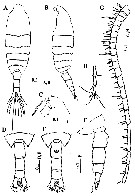 Issued from : M.M. El-Sherbiny & A.M. Al-Aidaroos in Zootaxa, 2015, 3911 (3). [p.399, Fig.2]. Female (from 21°41.37'N, 39°2.13'E): A-B, habitus (dorsal and lateral, respectively); C, rostrum (lateral); D, urosome (dorsal); E, same (ventral); F, same (lateral); G-H, A1.
Scale bars in mm.
|
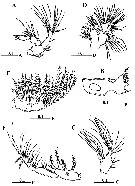 Issued from : M.M. El-Sherbiny & A.M. Al-Aidaroos in Zootaxa, 2015, 3911 (3). [p.402, Fig.3]. Female: A, A2; B, Md (gnathobase); C, Md (palp); D, Mx1; E, Mx2; F, Mxp. Scale bars in mm.
|
 Issued from : M.M. El-Sherbiny & A.M. Al-Aidaroos in Zootaxa, 2015, 3911 (3). [p.403, Fig.5]. Female: A, P1; B, P2; C, P3; D, P4; E, P5; F, endopod of left P5; G, left medial process of 2nd exopodal segment of P5; H, right medial process of 2nd exopodal segment of P5. Scale bars in mm.
|
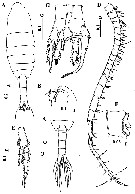 Issued from : M.M. El-Sherbiny & A.M. Al-Aidaroos in Zootaxa, 2015, 3911 (3). [p.404, Fig.6]. Male: A, habitus (dorsal); B, rostrum (ventro-lateral); C, urosome (dorsal); D, right A1; E, right P4; F, basis of right P4 (posterior view); G, P5 (posterior view). Scale bars in mm.
|
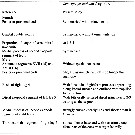 Issued from : M.M. El-Sherbiny & A.M. Al-Aidaroos in Zootaxa, 2015, 3911 (3). [p.408, Table 2]. Female & Male: morphological features. Compare with C. orsinii and C. halinus.
|
 Issued from : M.M. El-Sherbiny & A.M. Al-Aidaroos in Zootaxa, 2015, 3911 (3). [p.400, Fig.3]. Female (SEM micrograph): A, rostrum (lateral).
|
 Issued from : M.M. El-Sherbiny & A.M. Al-Aidaroos in Zootaxa, 2015, 3911 (3). [p.400, Fig.3]. Female (SEM micrograph): B, urosome (lateral); C, genital double-somite (lateral).
|
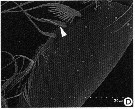 Issued from : M.M. El-Sherbiny & A.M. Al-Aidaroos in Zootaxa, 2015, 3911 (3). [p.400, Fig.3]. Female (SEM micrograph): D, Mxp basis (middle seta with proximal, spirally located spinule indicated by arrow).
|
 Issued from : M.M. El-Sherbiny & A.M. Al-Aidaroos in Zootaxa, 2015, 3911 (3). [p.400, Fig.3]. Female (SEM micrograph): E, medial process of 2nd exopodal segment of P5 (indicated by arrow): F, enlarged medial process of 2nd exopodal segment of P5 (indicated by arrow).
|
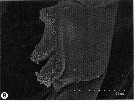 Issued from : M.M. El-Sherbiny & A.M. Al-Aidaroos in Zootaxa, 2015, 3911 (3). [p.406, Fig.7]. Male (SEM micrograph): B, basis of right P4 (posterior view).
|
 Issued from : M.M. El-Sherbiny & A.M. Al-Aidaroos in Zootaxa, 2015, 3911 (3). [p.406, Fig.7]. Male (SEM micrograph): C, fused exopodal segments 2 and 3 of left P5; D, 3rd exopodal segment of right P5 (serration of distal part indicated by arrow).
|
 ssued from : M.M. El-Sherbiny & A.M. Al-Aidaroos in Zootaxa, 2015, 3911 (3). [p.401]. Armature of legs P1 to P5 (female) Spines denoted by Roman numerals, setae by Arabic numerals. Elements on the outer margin of any segment are given first, separated by a hyphen from the inner margin elements (Huys & Boxshall, 1991).
| | | | | NZ: | 1 | | |
|
Carte de distribution de Centropages mohamedi par zones géographiques
|
| | | | Loc: | | | Red Sea (off Obhur Creek, Jeddah).
Type locality: 21°41.398'N, 39°3.002'E. | | | | N: | 1 | | | | Lg.: | | | (1178) F: 1,31-1,45; M: 1,2; {F: 1,31-1,45; M: 1,20} | | | | Rem.: | For El-Sherbiny & Al-Aidaroos (2015, p.406) this species is distinguished from the two closely species C. orsinii and C. halinus, as well other known species, in thet : 1- the posterior prosome ends of both sexes are almost symmetrical and weakly pointed; 2- the female genital double-somite is symmetrical with the seminal receptacle located posteriorly along the ventral surface and covered with a blunt operculum; 3- the symetry of female leg 5 which has a 3-segmented exopod, of which the 2nd exopod segment bears a strong medial process, slightly longer than the segment itself and with bilateral serration along distal part of posterior margin; 4- the basis of male right leg 4 bears 3 rounded outer border digitiform perocesses that are outlined with papillae-like structures; 5- the 2nd exopodal segment of male right leg 5 bears a strong medial process curved at almost 90 degree to its segment; 6- the 3rd exopodal segment of male right leg 5 is curved distally with spinules along its outer margin.
The basis of male leg 4 are asymmetrical, with the right one characterized by digitiform processes spreading along the lateral surface. Similar processes are present on the male right leg basis of C. orsinii collected from different regions with variability in the precise form of the processes (see in Boxshall & Jaume, 2011). Based on our specimens of C. orsinii collected from Obhur Creek, the processes of the right P4 are mostly as shown by Mulyadi (2004) from Indonesian waters.
The mtCOI has been used as an appropriate marker for species level studies because it contains sufficient diversity to adress intra- and interspecific phylogenetic relationships. The 20.8 % difference between C. mohamedi and C. orsinii suggests that these two species have been genetically isolated for some time.
Of these three species C. orsinii, C. mohamedi, C. halinus, mohamedi is not only recorded from the type locality but also along the Saudi Arabian coastal waters of the Red Sea (unpublished data).
Asymetry of the leg 5 is fairly common to adult male calanoids, while asymetry of the leg 4 is very rare in copepods. It is remarkable that the male reveals an asymmetry in leg P4, in which the basis of the right leg carries on its posterior surface 3 rounded digitiform processes outlined by papillae-like structures.
C. mohamedi belongs to the orsinii species-group. | | | Dernière mise à jour : 17/11/2015 | |
|
|
 Toute utilisation de ce site pour une publication sera mentionnée avec la référence suivante : Toute utilisation de ce site pour une publication sera mentionnée avec la référence suivante :
Razouls C., Desreumaux N., Kouwenberg J. et de Bovée F., 2005-2025. - Biodiversité des Copépodes planctoniques marins (morphologie, répartition géographique et données biologiques). Sorbonne Université, CNRS. Disponible sur http://copepodes.obs-banyuls.fr [Accédé le 23 octobre 2025] © copyright 2005-2025 Sorbonne Université, CNRS
|
|
 |
 |












